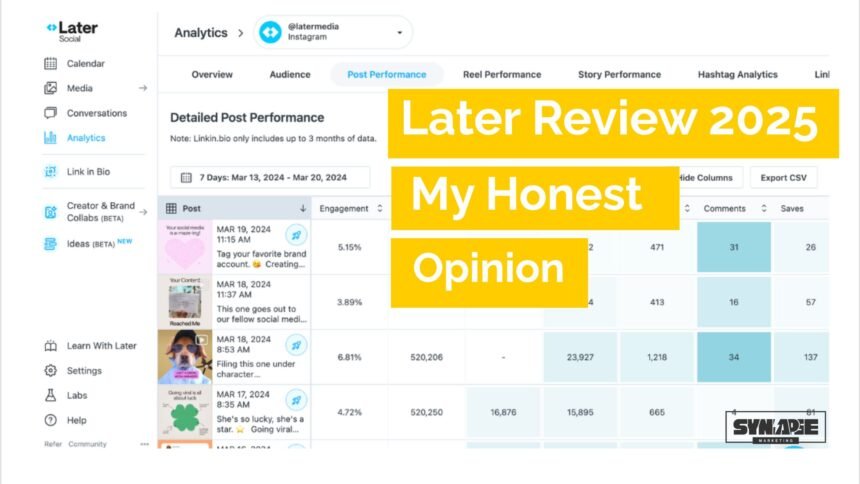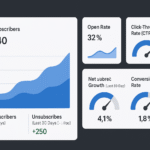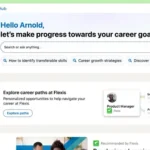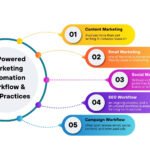Managing social media in 2025 isn’t optional, it’s a full-time necessity. Whether you’re a solo creator, a small business owner, or part of a growing marketing team, chances are you’re juggling multiple platforms, content formats, and audience demands all at once. That’s where social media scheduling tools like Later come into play.
In this Later Review, I’ll walk you through everything you need to know about the platform, from its core features to its pricing structure, and how it stacks up against competitors like Buffer and Hootsuite. I’ve spent hours testing the tool hands-on, combing through user feedback, and comparing it side by side with other scheduling platforms, so you don’t have to.
What makes Later different is its strong visual-first approach, especially for Instagram and Pinterest. If you’re the kind of marketer who thrives on planning content visually, you’ll appreciate the drag-and-drop scheduler and real-time feed previews.
But Later isn’t perfect and it’s not for everyone. This review will break down who it’s best for, what it lacks, and whether it’s worth your money in 2025.
Let’s dive in and by the end, you’ll know if Later belongs in your social media stack.
What Is Later?
Later is a visual social media scheduling tool originally built for Instagram but has since expanded to support TikTok, Facebook, LinkedIn, Pinterest, and X (formerly Twitter). Founded in 2014 as “Latergramme,” the platform quickly gained traction for its ability to plan Instagram content in a way that felt intuitive and design-first qualities that still define its user experience today.
Unlike more complex tools aimed at enterprise teams, Later is purposefully simplified for individuals and small businesses. At its core, the platform helps users visually map out their content calendar, drag and drop posts into time slots, and preview their Instagram grid before anything goes live. But over the years, it’s grown into more than just a scheduler.
Today, Later offers a media library for storing brand assets, AI-powered hashtag suggestions, basic analytics, and even a link-in-bio tool that helps convert followers into traffic and sales. For TikTok and Pinterest users, Later includes features to schedule videos and pins with ease though Instagram remains its stronghold.
If you’ve been hunting for a clean, Instagram-first scheduler that doesn’t overwhelm you with features you’ll never use, this Later Review will show you why it’s consistently one of the most talked-about tools in the market.
6 Powerful Features You’ll Find in Later
One of the main reasons I decided to write this Later Review is because I kept hearing marketers rave about its features but hype doesn’t always translate to substance. So, I tested everything myself. Here’s what stood out.
1. Visual Content Calendar (Drag-and-Drop)
This is Later’s bread and butter. The visual scheduler lets you drag and drop your posts into a weekly or monthly calendar. As someone who creates a high volume of content, I found this helpful not just for organization but for spotting gaps and content overlap. It supports scheduling for Instagram, TikTok, Facebook, LinkedIn, Twitter, and Pinterest—all in one dashboard.
2. Instagram Feed Preview
If your brand relies heavily on Instagram aesthetics (like mine does), you’ll love this. The feed preview shows how your upcoming posts will look on your Instagram grid before publishing. It’s an essential feature for creators, lifestyle brands, and agencies managing client accounts.
3. Media Library
Later’s Media Library lets you upload, tag, and categorize photos and videos. You can even label content by campaign or theme, which makes repurposing a breeze. The feature is especially useful if you have a small team collaborating on assets.
4. Analytics Dashboard
While not as deep as what you’d find in Sprout Social or Hootsuite, Later does offer solid basic analytics. You can track engagement metrics, follower growth, and even optimal posting times. Reports are downloadable, and while limited in the free plan, they become far more detailed in the paid tiers.
5. Hashtag Suggestions + Best Time to Post
This one surprised me. Later suggests hashtags based on your previous post performance, and offers a “Best Time to Post” window based on historical engagement data. It’s simple, but useful. I found it helped boost reach on a few experimental posts.
6. Stories, Reels, and Carousel Scheduling
Yes, Later lets you schedule Instagram Stories, Reels, and carousel posts. However, auto-publishing isn’t supported for every format you’ll need push notifications for some of them. Still, it makes multi-format planning far less chaotic.
Overall, Later’s feature set strikes a balance between simplicity and power. It won’t overwhelm you with enterprise-level complexity, but it absolutely covers what most creators and small teams need to grow consistently.
How Much Does Later Cost in 2025?
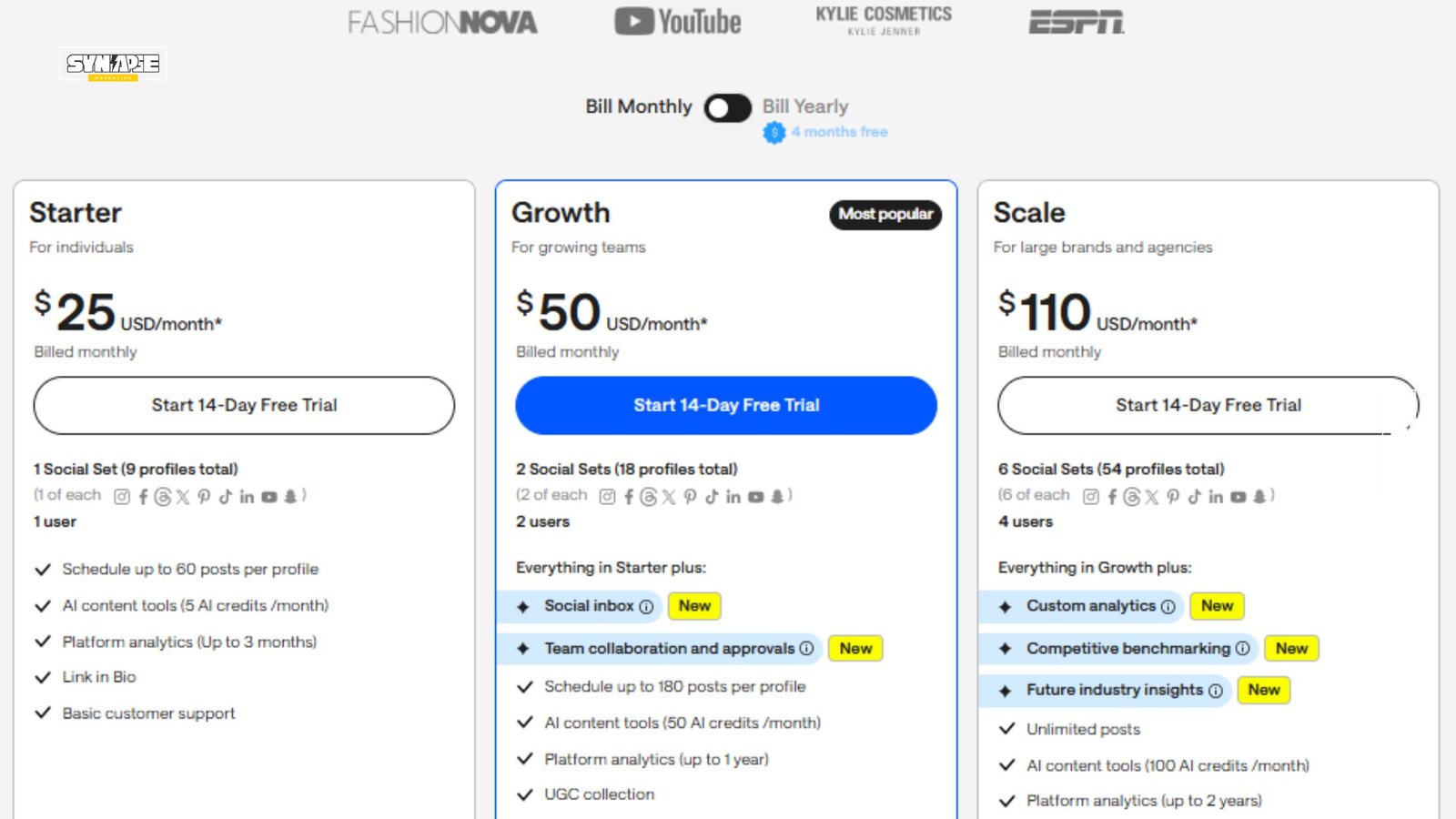
One of the most common questions I get and a big reason people end up reading a Later Review like this is: Is Later worth the price?
I’ve tested both the free and paid tiers of Later, and here’s the breakdown of what each plan offers in 2025:
Free Plan
If you’re just starting out, Later’s free plan is generous enough to get a feel for the platform. You can connect 1 profile per social network and schedule up to 10 posts per profile each month. However, you’ll miss out on analytics, Stories/Reels scheduling, and collaboration tools.
This plan is great for personal brands or creators publishing less frequently—but it’s definitely not enough for a growing business.
Starter Plan – $25/month
This is where things start getting serious. You get 1 user, 1 set of social profiles, and access to Instagram Stories scheduling, basic analytics, and the “best time to post” feature. If you’re a solo creator or freelancer, this tier offers good value.
Growth Plan – $50/month
Designed for small teams, this plan unlocks 3 users and unlimited post scheduling across all platforms. You also gain access to more detailed analytics and advanced performance reporting. For agencies or in-house social teams, this tier is usually the sweet spot.
Advanced Plan – $110/month
This one’s built for larger teams. It includes 6 users, full analytics, custom user permissions, and faster support response times. If you manage multiple brands or clients, this tier might make sense.
From a pricing perspective, Later falls in the mid-range. It’s not as cheap as Publer, but more affordable than Sprout Social or Hootsuite. You’re paying for a visual-first interface and time-saving tools that work especially well for Instagram-heavy workflows.
In my experience, if Instagram or TikTok is core to your strategy, the value Later provides outweighs the cost—especially from the Growth plan upward.
Is Later Easy to Use? A Look at the UX
Ease of use is one of the main reasons I’ve stuck with Later over other scheduling tools. In this Later Review, I can confidently say that if you’re looking for a social media scheduler with a clean interface and minimal learning curve, Later delivers.
The dashboard is intuitive. Scheduling posts is as easy as dragging content from your Media Library onto the calendar. The platform’s visual-first layout makes it especially great for Instagram planning—you can see your grid exactly as it will appear before publishing. That matters a lot if your brand leans on aesthetic consistency.
Switching between different platforms like TikTok, LinkedIn, or Pinterest is seamless. There’s no clutter or confusing menus. The mobile app works well too, and while I prefer the desktop version for heavy lifting, the mobile app is handy for push notifications (especially when scheduling Instagram Stories or Reels).
That said, there is a brief setup process that involves linking social profiles and enabling permissions—Instagram in particular can be slightly tricky due to Meta’s API restrictions. But Later walks you through it with clear steps.
For creators, freelancers, and social media managers, the user experience is straightforward, efficient, and well-designed for real-world publishing workflows.
Pros and Cons of Using Later
No Later Review would be complete without an honest look at where the platform shines—and where it falls short. After weeks of hands-on use and cross-comparisons with other schedulers like Buffer and Hootsuite, here’s what I’ve found.
Pros
- Visual Scheduling: Later’s drag-and-drop calendar and Instagram grid preview make content planning genuinely easier. It’s one of the most user-friendly platforms I’ve tested.
- Great for Instagram and Pinterest: If your brand is visual-heavy, this tool feels tailor-made for your workflow.
- Media Library Management: Organizing assets with tags, labels, and folders is a huge time-saver.
- Free Plan Available: You can get started without spending a dime, which is ideal for testing.
Cons
- Limited Free Plan: The 10-post cap per profile/month gets restrictive fast, especially for growing brands.
- Push Notifications for Stories & Reels: Auto-publishing isn’t fully supported for all post types. You’ll still need manual steps for some content formats.
- Basic Analytics: While Later provides insights, they aren’t as deep or customizable as what you’d get from Sprout Social or similar platforms.
If you’re an Instagram-first business or creator, these pros likely outweigh the cons. But if you need robust analytics or more automation, you might find the limitations frustrating.
Later vs Buffer, Hootsuite & More – Which Wins?
Comparing tools is where most people get stuck—and I get it. There are dozens of social media schedulers out there, and many offer similar promises. So in this part of my Later Review, I’ll break down how Later stacks up against the most popular alternatives.
Later vs Buffer
Buffer is a fantastic all-rounder with strong analytics and a clean interface. It supports a wider range of platforms, including Mastodon and Google Business Profiles. But where Buffer falls short is visual planning. Later’s Instagram feed preview and media-first calendar are far more intuitive for brands prioritizing aesthetics. If Instagram is your focus, Later has the edge.
Later vs Hootsuite
Hootsuite is built for large teams and enterprise-level needs. It offers robust reporting, deep integrations, and team workflows. But it comes with a steep learning curve—and a hefty price tag. Later is more beginner-friendly, and while it doesn’t offer advanced monitoring or CRM tools, it’s significantly easier to master.
Later vs Planoly / Publer / Metricool
Planoly shares Later’s visual strengths but is more Instagram-specific. Publer and Metricool are newer players with broader automation features, like content recycling and multi-post customization. That said, they lack the polish of Later’s interface.
Bottom line? If you’re a content creator, solo marketer, or small business focused on Instagram, TikTok, or Pinterest, Later gives you just the right tools—without overwhelming you.
Is Later Right for You?
As I’ve written this Later Review, one question keeps coming up: Who is this platform actually built for? The answer depends on how you work and what platforms matter most to your brand.
If you’re a content creator, influencer, or small business owner focused on visual platforms like Instagram, TikTok, and Pinterest, Later hits the sweet spot. The visual scheduler, hashtag suggestions, and Instagram feed preview help you stay on-brand and organized.
Agencies with a few clients and lean internal teams can also benefit—especially from the Growth or Advanced plans, which support multi-user collaboration and analytics.
But if you’re managing large-scale campaigns, need deep reporting, or require features like competitor monitoring and full automation, you might outgrow Later fast. In those cases, platforms like Sprout Social or Agorapulse may be better suited.
For the rest of us? Later is a clean, focused, and effective tool that just works.
My Final Take on Later Review
After thoroughly testing the platform across different use cases, I can say with confidence that Later is one of the most approachable and visually intuitive social media scheduling tools available in 2025. It’s not overloaded with enterprise features—and that’s part of its charm.
For individuals, creators, and small marketing teams that prioritize Instagram, TikTok, or Pinterest, Later makes content planning feel less like a chore and more like a creative process. It simplifies your workflow, offers just enough analytics, and makes visual scheduling genuinely useful.
That said, it’s not the best choice if you need deep cross-platform reporting, social listening, or more advanced automation. But for its target user base, Later does the job—and it does it well.
Frequently Asked Questions About Later Review 2025
Is Later free to use?
Yes—Later offers a free plan that includes one profile per platform and up to 10 scheduled posts per profile each month. It’s great for testing the tool or managing light content schedules, but you’ll need to upgrade for full analytics and Stories/Reels scheduling.
Can Later auto-publish to Instagram?
It depends on the post type. Later can auto-publish single image posts and carousels for business profiles. However, Instagram Stories and Reels still require push notifications and manual confirmation via the mobile app due to Meta’s API limitations.
Does Later support TikTok and Pinterest?
Yes. You can schedule and manage content for TikTok and Pinterest, alongside Instagram, Facebook, X (formerly Twitter), and LinkedIn. While Instagram remains its strongest platform, Later is expanding its TikTok capabilities as well.
How does Later compare with Buffer?
Buffer offers more advanced analytics and platform support, but Later wins on visual scheduling, ease of use, and Instagram-centric features. I recommend Buffer for cross-platform strategy; Later for visual-first workflows.
Is Later worth the price?
If you’re managing visual content and want simplicity without sacrificing function, Later is absolutely worth it—especially at the Starter and Growth plan levels.
References
If you’re ready to try Later or want to explore its features further, here are some resources I recommend:
- Official Later Website – Sign up for the free plan or explore premium options
- Later Help Center – Step-by-step guides and troubleshooting
- Compare Later vs Buffer – Direct competitor breakdown
- Top 10 Social Media Schedulers in 2025 – My curated list of alternatives based on features, pricing, and performance
- G2 Reviews
- Capterra User Feedback
- Trustpilot
- Influencer Marketing Hub – Later Review
- Website Planet – Later Review


